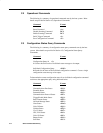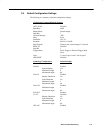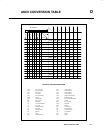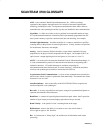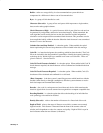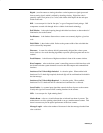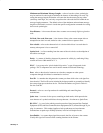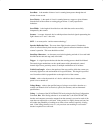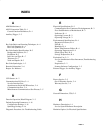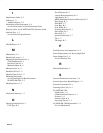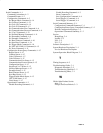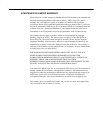
Glossary–4
Minimum and Maximum Message Lengths– refers to how the various symbologies
may be restricted in code length to minimize the chances of misreading a bar code. By
setting the message length, the decoder will count the data characters plus any others
(start/stop, check digit, etc.) and only accept those bar code reads that fall within the set
message length parameters. The default values of the minimum and maximum message
lengths are indicated in section 4.4 under the specific configuration commands for setting
the bar code symbologies.
Near Distance– is the nearest distance that a scanner can accurately digitize a given bar
code.
No Read, Non–read, Non–scan– is the absence of data at the scanner output after an
attempted scan due to no code, defective code, scanner failure or operator error.
Non–volatile– refers to the characteristic of a device which allows it to retain data in
memory when power is lost or turned off.
Optical Axis– is a line extending from the center of the exit window to the midpoint of
the usable scan length.
Parity– is a means of checking character bit patterns for validity by confirming if they
contain an Even or Odd number of “1”s.
PLCC– is an acronym for “plastic leaded chip carrier,” a type of integrated circuit
package. PLCC components are used in surface mount circuit board technology.
Port– refers to the electrical connector on a decoder, computer or other system
component through which data is transmitted or received.
Port ID– is a number that designates the scanner port from which a bar code signal has
been decoded. The Port ID can be included in the data preamble or postamble to identify
the scanner input port to the host device. The Port ID numbers are given in Table 4.1.
See also Code ID.
Protocol– refers to a set of procedures for establishing and controlling data
transmissions.
Quiet Area– is an area of clear space, containing no dark marks, which precedes the
start character of a symbol and follows the stop character. Also known as Quiet Zone.
RS–232–C– is a set of rules which govern the transfer of data between Data Terminal
Equipment (DTE) and Data Communications Equipment (DCE), effected through 25 pin
plug–in connectors. This standard applies to both synchronous and asynchronous
transmissions at speeds up to 20K bps (bits/sec) in full or half–duplex modes.
Scan Enable– is a scanner input signal that controls the flow of power to the scanner.
Usually this signal will control all the scanning functions in the scanner.



